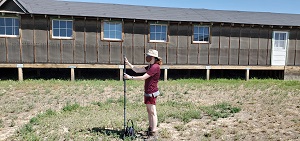Modeling Minidoka
Hannah Gulick, a graduate student in the Cultural Resource Management Program, uses virtual reality to educate the public at sites of trauma, specifically at the Minidoka National Historic Site in Idaho. Following the attack on Pearl Harbor, Minidoka served as a Japanese internment camp from 1942 until its closing in 1945. Gulick, who also has her Master's in Japanese, saw Minidoka as the perfect opportunity to combine her interests in Japanese, virtual reality, and history to help educate others about the site.
Here, thousands of Japanese Americans were forced from their homes on the west coast and stripped of their basic constitutional rights. For many victims, and their descendants, the historic site of Minidoka remains a source of trauma. Gulick’s research focuses on the educational and healing properties of virtual reality (VR) in regard to Minidoka.
Today, little remains of Minidoka. Upon its closing, many of the buildings were auctioned off. Furthermore, those who are interested in visiting the site would have to make the drive to Hunt in south-central Idaho, making it relatively inaccessible for out-of-state visitors. With this information, Gulick began to explore the capabilities of VR.
VR provides a visual simulation that can be viewed in the convenience of one’s home through a headset, phone, tablet, and other such devices. This technology is already being utilized in institutions worldwide, such as the Louvre Museum, to help visitors experience historical events where the site or time period is inaccessible. Gulick explains that the implementation of VR in regards to Minidoka has significant benefits by allowing visitors to see the camp as it once was.
Along with overcoming physical barriers associated with site inaccessibility, Gulick found that VR can also help victims heal from trauma. As VR continues to grow in public use, it is now being used in trauma treatment centers to help patients with PTSD (Post Traumatic Stress Disorder). VR is beneficial in trauma treatment as it creates a controlled, safe environment where people can process the trauma that they have experienced.
Gulick proposes that this same approach can be taken to help victims and their families heal from their traumas associated with Minidoka. While there is an annual pilgrimage out to Minidoka to help victims heal, VR offers an alternative to those who cannot make the trip or are not ready to see the site in person.
With this information, Gulick began mapping out the site using ArcGIS, a geographic information system. She gathered aerial footage of the current land layout and compared it to the assumed layout of the camp back in 1942. In July of 2020, Gulick traveled out to the Minidoka site, spoke with a historical interpreter, and took building measurements to get a better idea of the camp’s layout.
After the onsite research was completed, Gulick then modeled one of the barracks using SketchUp Pro, a 3D modeling computer program. Due to a lack of photographs and details of the interior of the barracks, some interpretation was needed. After the modeling was completed, it was animated in Unity, a game development software, where the finishing touches such as texture, color, and shadows were added.
When Gulick’s VR project is completed, it will be a prototype. She emphasizes that with proper funding and professional help, the Minidoka VR will be more accurate and accessible, profoundly benefiting users.
At CMU We Do Research, We Do Real World
Story by ORGS intern Hailey Nelson
June 2021
